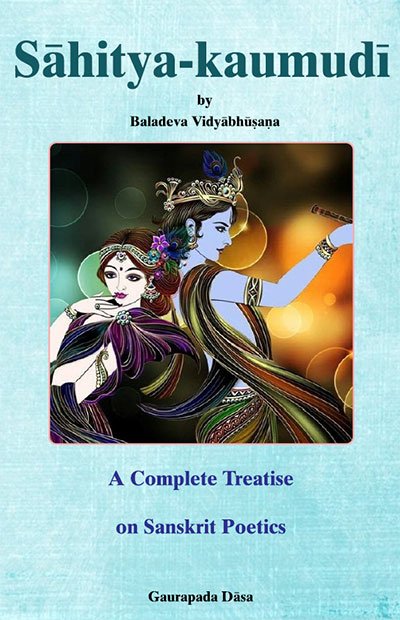Sahitya-kaumudi by Baladeva Vidyabhushana
by Gaurapada Dāsa | 2015 | 234,703 words
Baladeva Vidyabhusana’s Sahitya-kaumudi covers all aspects of poetical theory except the topic of dramaturgy. All the definitions of poetical concepts are taken from Mammata’s Kavya-prakasha, the most authoritative work on Sanskrit poetical rhetoric. Baladeva Vidyabhushana added the eleventh chapter, where he expounds additional ornaments from Visv...
Text 10.96
क्रमेणोदाहरणम्,
नदीनां च वधूनां च इत्य् आदि। अत्र प्रेम्णां प्रकृतत्वाद् उपमेयत्वम्। नद्य्-आदीनाम् अप्रकृतत्वाद् उपमानत्वम्। वक्र-गति-रूपो धर्मस् तु सकृद् उपात्तः।
krameṇodāharaṇam,
nadīnāṃ ca vadhūnāṃ ca ity ādi. atra premṇāṃ prakṛtatvād upameyatvam. nady-ādīnām aprakṛtatvād upamānatvam. vakra-gati-rūpo dharmas tu sakṛd upāttaḥ.
Examples are shown in order. The verse that begins nadīnāṃ ca (4.19) illustrates the first variety of dīpaka (kriyā-dīpaka): “The course of rivers, the manners of women, the motions of snakes, and the ways of love are always crooked. No cause can account for them” (4.19) (Alaṅkāra-kaustubha 5.38). In this verse, love is the upameya because it is the subject of description. The rivers and so on are the upamānas since they are not the subjects of description. The common attribute, “having a crooked motion,” is stated once.
Commentary:
Mammaṭa says dīpaka (lamp) is so called because the attribute, situated in one place, sheds light on the whole statement.[1] Jagannātha says dīpaka signifies that the attribute sheds light on the prakṛta and on the aprakṛta. In other words it makes them shine from a literary point of view. Alternatively, he says dīpaka means it is like a lamp.[2] Either the suffix [ṇ]aka is applied after the verbal root dīp[ī] dīptau (to illuminate), or the suffix ka[n] is applied after dīpa (lamp) in the sense of iva (like), as in the word yamaka, by the rule: ive pratikṛtau (Aṣṭādhyāyī 5.3.96).
In the ancient rhetoricians’ methodology, there were three varieties of dīpaka, depending on whether the attribute is placed at the beginning (ādi-dīpaka), middle (madhya-dīpaka) or end (antya-dīpaka) of the verse. The idea was to give style to the verse by so positioning the word expressive of the attribute, like one might place a lamp in the corner or in the middle of a room for a stylistic effect. Mammaṭa was the first poetical theorist to reject those three varieties. In other words, dīpaka is like a lamp, and that lamp is the attribute that as if illuminates all the nouns for the purpose of bringing to light a similarity between them.
Kriyā-dīpaka (one verb for many nouns) is similar to the tulya-yogitā ornament (equal connection with an attribute) (10.100). The only difference is that in dīpaka, one thing is the subject of description and the other things are not the subject of description. By contrast, in tulya-yogitā, all the things are either contextual or noncontextual. Determining whether a single verse without a context and without a vocative is a dīpaka or a tulya-yogitā is often a matter of choice, according to Paṇḍita-rāja Jagannātha.[3]
This is his example of kriyā-dīpaka with a vocative (which establishes a context):
sudhāyāś candrikāyāś ca sañjīvanyā mahauṣadheḥ |
dayā-dṛṣṭeś ca te rājan viśva-sañjīvanaṃ guṇaḥ ||“Nectar, moonlight, the sañjīvanī herb, and your glance of compassion, O king, have the quality of enlivening the world” (Rasa-gaṅgādhara, KM p. 323).
Footnotes and references:
[1]:
